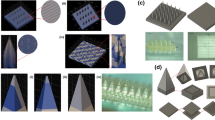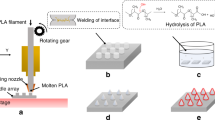Abstract
Purpose
To fabricate microneedle arrays directly off a photomask using a simple photolithographical approach and evaluate their potential for delivering collagen.
Methods
A simple photolithographical approach was developed by using photomask consisting of embedded micro-lenses that govern microneedle geometry in a mould free process. Microneedle length was controlled by use of simple glass scaffolds as well as addition of backing layer. The fabricated arrays were tested for their mechanical properties by using a force gauge as well as insertion into human skin with trypan blue staining. Microneedle arrays were then evaluated for the delivery of fluorescent collagen, which was evaluated using a confocal laser scanning microscope.
Results
Microneedles with sharp tips ranging between 41.5 ± 8.4 μm and 71.6 ± 13.7 μm as well as of two different lengths of 1336 ± 193 μm and 957 ± 171 μm were fabricated by using the photomasks. The microneedles were robust and resisted fracture forces up to 25 N. They were also shown to penetrate cadaver human skin samples with ease; especially microneedle arrays with shorter length of 957 μm penetrated up to 72% of needles. The needles were shown to enhance permeation of collagen through cadaver rat skin, as compared to passive diffusion of collagen.
Conclusions
A simple and mould free approach of fabricating polymeric microneedle array is proposed. The fabricated microneedle arrays enhance collagen permeation through skin.






Similar content being viewed by others
References
Zhou CP, Liu YL, Wang HL, Zhang PX, Zhang JL. Transdermal delivery of insulin using microneedle rollers in vivo. Int J Pharm. 2010;392:127–33.
Lee JW, Choi SO, Felner EI, Prausnitz MR. Dissolving microneedle patch for transdermal delivery of human growth hormone. Small. 2011;7:531–9.
Raphael AP, Prow TW, Crichton ML, Chen XF, Fernando GIP, Kendall MAF. Targeted, needle-free vaccinations in skin using multi layered. Densely-packed dissolving microprojection arrays. Small. 2010;6:1785–93.
Hirobe S, Azukizawa H, Matsuo K, Zhai Y, Quan Y-S, Kamiyama F, et al. Development and clinical study of a self-dissolving microneedle patch for transcutaneous immunization device. Pharm Res. 2013;30:2664–74.
Kim YC, Park JH, Prausnitz MR. Microneedles for drug and vaccine delivery. Adv Drug Deliv Rev. 2012;64:1547–68.
Park JH, Allen MG, Prausnitz MR. Polymer microneedles for controlled-release drug delivery. Pharm Res. 2006;23:1008–19.
Park JH, Yoon YK, Choi SO, Prausnitz MR, Allen MG. Tapered conical polymer microneedles fabricated using an integrated lens technique for transdermal drug delivery. IEEE Trans Biomed Eng. 2007;54:903–13.
Zhang Y, Lin CT, Yang S. Fabrication of hierarchical pillar arrays from thermoplastic and photosensitive SU-8. Small. 2010;6:768–75.
Arora A, Prausnitz MR, Mitragotri S. Micro-scale devices for transdermal drug delivery. Int J Pharm. 2008;364:227–36.
Kochhar JS, Goh WJ, Chan SY, Kang L. A simple method of microneedle array fabrication for transdermal drug delivery. Drug Dev Ind Pharm. 2013;39:299–309.
Tay FEH, Iliescu C, Jing J, Miao J. Defect-free wet etching through pyrex glass using Cr/Au mask. Microsyst Technol. 2006;12:935–9.
Iliescu C, Chen B, Miao J. On the wet etching of Pyrex glass. Sensors Actuators A Phys. 2008;143:154–61.
Iliescu C, Jing J, Tay FEH, Miao J, Sun T. Characterization of masking layers for deep wet etching of glass in an improved HF/HCl solution. Surf Coat Technol. 2005;198:314–8.
Davis SP, Landis BJ, Adams ZH, Allen MG, Prausnitz MR. Insertion of microneedles into skin: measurement and prediction of insertion force and needle fracture force. J Biomech. 2004;37:1155–63.
Varshney M, Khanna T, Changez M. Effects of AOT micellar systems on the transdermal permeation of glyceryl trinitrate. Colloids Surf B: Biointerfaces. 1999;13:1–11.
Kochhar JS, Zou S, Chan SY, Kang L. Protein encapsulation in polymeric microneedles by photolithography. Int J Nanomedicine. 2012;7:3143–54.
Peebles L, Norris B. Filling ‘gaps’ in strength data for design. Appl Ergon. 2003;34:73–88.
Sugiyama K, Yamamoto K, Kamata O, Katsuda N. A simple and rapid assay for collagenase activity using fluorescence-labeled substrate. Kurume Med J. 1980;27:63–9.
Walsh AJ, Masters DB, Jansen ED, Welch AJ, Mahadevan-Jansen A. The effect of temperature on the autofluorescence of scattering and non-scattering tissue. Lasers Surg Med. 2012;44:712–8.
Zipfel WR, Williams RM, Christie R, Nikitin AY, Hyman BT, Webb WW. Live tissue intrinsic emission microscopy using multiphoton-excited native fluorescence and second harmonic generation. Proc Natl Acad Sci U S A. 2003;100:7075–80.
Schonenbrucher H, Adhikary R, Mukherjee P, Casey TA, Rasmussen MA, Maistrovich FD, et al. Fluorescence-based method, exploiting lipofuscin, for real-time detection of central nervous system tissues on bovine carcasses. J Agric Food Chem. 2008;56:6220–6.
Gittard SD, Ovsianikov A, Chichkov BN, Doraiswamy A, Narayan RJ. Two-photon polymerization of microneedles for transdermal drug delivery. Expert Opin Drug Deliv. 2010;7:513–33.
Choi CK, Kim JB, Jang EH, Youn YN, Ryu WH. Curved biodegradable microneedles for vascular drug delivery. Small. 2012;8:2483–8.
Nichol JW, Koshy ST, Bae H, Hwang CM, Yamanlar S, Khademhosseini A. Cell-laden microengineered gelatin methacrylate hydrogels. Biomaterials. 2010;31:5536–44.
Friedman GB, Sandhu HS. Longitudinal spherical aberration of a thin lens. Am J Phys. 1967;35:628.
Lin TW, Chen CF, Yang JJ, Liao YS. A dual-directional light-control film with a high-sag and high-asymmetrical-shape microlens array fabricated by a UV imprinting process. J Micromech Microeng. 2008;18:095029. doi:10.1088/0960-1317/18/9/095029.
Dunne SM, Millar BJ. Effect of distance from curing light tip to restoration surface on depth of cure of composite resin. Prim Dent Care. 2008;15:147–52.
Park JH, Prausnitz MR. Analysis of mechanical failure of polymer microneedles by axial force. J Korean Phys Soc. 2010;56:1223–7.
Kochhar JS, Quek TC, Soon WJ, Choi J, Zou S, Kang L. Effect of microneedle geometry and supporting substrate on microneedle array penetration into skin. J Pharm Sci. 2013;102:4100–8.
Pilcher BK, Sudbeck BD, Dumin JA, Welgus HG, Parks WC. Collagenase-1 and collagen in epidermal repair. Arch Dermatol Res. 1998;290(Suppl):S37–46.
Sitterley G. Collagen attachment protocols, solubility, and stability. http://www.sigmaaldrich.com/technical-documents/articles/biofiles/collagen-product-protocols.html (accessed December 2 2013).
Varani J, Dame MK, Rittie L, Fligiel SEG, Kang S, Fisher GJ, et al. Decreased collagen production in chronologically aged skin—roles of age-dependent alteration in fibroblast function and defective mechanical stimulation. Am J Pathol. 2006;168:1861–8.
Anonymous. The “new” collagen: potential medical uses may abound. This protein may be altered to create products for oral surgery, treating burns, and stem cell production. Health News. 2006;12:14–5.
Yamaguchi K, Mitsui T, Aso Y, Sugibayashi K. Structure-permeability relationship analysis of the permeation barrier properties of the stratum corneum and viable epidermis/dermis of rat skin. J Pharm Sci. 2008;97:4391–403.
Marinkovich M, Lane AT, Rajadas J. Production and delivery of a stable collagen. 2012, WIPO Patent WO/2012/149136.
Acknowledgments And Disclosures
The authors would like to acknowledge the staff of SBIC-Nikon Imaging Centre (Singapore) and Dr. Adam Cliffe from Leica Microsystems for the assistance provided in imaging the microneedle samples and skin samples. This study was supported by a National Research Foundation Grant NRF2012NRF-POC001-043 and NRF University Innovation Fund through Innovation and Entrepreneurship Practicum Grant.
Author information
Authors and Affiliations
Corresponding author
Electronic supplementary material
Below is the link to the electronic supplementary material.
ESM 1
(DOCX 54 kb)
Rights and permissions
About this article
Cite this article
Kochhar, J.S., Anbalagan, P., Shelar, S.B. et al. Direct Microneedle Array Fabrication Off a Photomask to Deliver Collagen Through Skin. Pharm Res 31, 1724–1734 (2014). https://doi.org/10.1007/s11095-013-1275-1
Received:
Accepted:
Published:
Issue Date:
DOI: https://doi.org/10.1007/s11095-013-1275-1




